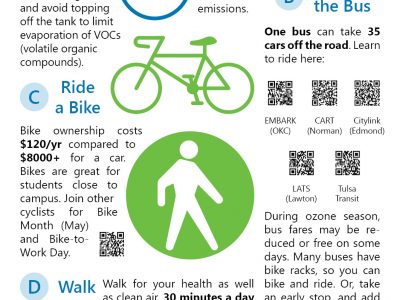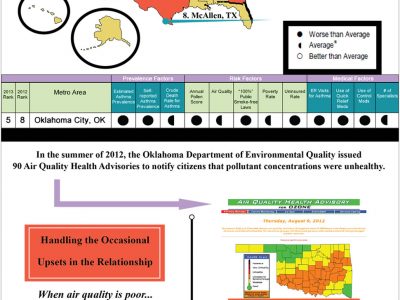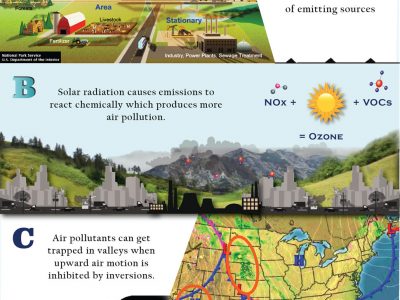Learning

Learn about air quality through our fact sheets, multimedia, and educational materials for schools.
- 10 Simple Steps to Improve Air Quality
- Air Quality Notifications
- An Efficient Roof That Pays You Back
- Asbestos In The Home
- Asbestos NESHAP Regulations
- Biodiesel
- Carbon Monoxide
- Choosing the Right Service A Lead Based Paint Inspection or Risk Assessment
- Diesel Idle Reduction
- Ethanol
- Fugitive Controls and Pollution Prevention Requirements for Perc Dry Cleaning Facilities
- Fugitive Dust and Its effects on Our Environment
- Guidance for Portable Electrochemical Analyzer Testing Used for Compliance Monitoring
- Health Impacts of Diesel Exhaust
- Is Oklahomas Air OK
- Lead In Air
- Nitrogen Dioxide
- Online Excess Emissions System
- Open Burning And You
- Operating, Recordkeeping, Monitoring Requirements For Dry Cleaning Facilities Using Perchloroethylene
- Ozone
- Particulate Matter
- Playground Equipment and Lead Based Paint Hazards
- Renovation Repair Painting Rule
- Sulfur Dioxide
- Waste and Emission Reduction Alternatives for Dry Cleaners
We have posted several videos on Youtube on air quality topics such as how we monitor for air and energy efficiency tips. More videos are available on DEQ’s Youtube channel.
Click on the image to view full size. Scroll below for text alternatives.
Clean Air |
Asthma |
Weather |
What Will You Do for Cleaner Air?
The atmosphere is huge, but our individual choices add up to big impacts on air quality. Follow these tips to help our air OK!
1. Move Cleaner
Vehicles are a major source of emissions that contribute to air pollution. Ozone is created when car pollutants react with sunlight. Hot and sunny summer days in Oklahoma can trigger high ozone levels, so drive cleaner and use alternative transportation.
A. Carpool
Share a ride to reduce traffic congestion and save $600+ in fuel and maintenance.
Drive Cleaner
You can also drive cleaner in your own car. Combine trips to save money and fuel. Refuel at night and avoid topping off the tank to limit evaporation of VOCs (volatile organic compounds). Finally, avoid idling your engine because it wastes fuel and can double your car’s air emissions.
B. Hop on the Bus
One bus can take 35 cars off the road. Learn to ride here:
- EMBARK (OKC) http://embarkok.com
- CART (Norman) http://www.ou.edu/cart.html
- Citylink (Edmond) http://www.citylinkedmond.com
- LATS (Lawton) http://ridelats.com
- Tulsa Transit http://tulsatransit.org
During ozone season, bus fares may be reduced or free on some days. Many buses have bike racks, so you can bike and ride. Or, take an early stop, and add a walk to your trip.
C. Ride a Bike
Bike ownership costs $120/yr compared to $8000+ for a car. Bikes are great for students close to campus. Join other cyclists for Bike Month (May) and Bike-to-Work Day.
D. Walk
Walk for your health as well as clean air. 30 minutes a day reduces your risk your heart disease, diabetes, and hypertension
2. Use Electric Lawn Care Equipment
Inefficient small engines spew unburnt fuel and oil. Using a gas lawn mower for one hour releases as much air pollution as driving a car for 45 miles. 17 million gallons of gas spill while refueling lawn equipment each year in the US. In 2015, we helped Central OK residents exchange 95 gas mowers for electric ones, cutting 19,800 lbs of annual emissions.
3. Choose a Low Pollution Boat Motor
Consider a 4-stroke or direct fuel injection 2-stroke engine versus a traditional 2-stroke model. These engines produce 75% less air emissions, use 35-50% less gas, and use 50% less oil.
4. Keep it Cleaner at Home
Energy vampires are unused but plugged-in devices drawing electricity which increase power plant emissions. Big users include computers, digital displays/TVs, cable/satellite boxes, phone chargers, and game consoles. These devices can add 10+% of your electric bill, so use power strips, unplug devices/chargers, and choose ENERGY STAR rated models.
Reduce VOC release at home by choosing low-VOC paints and carpets, and use brushes and rollers instead of spray painting. Also, tightly cap all solvent containers.
Conclusion
Keep our air OK.
Cleaner air starts with you.
Your choices count!
Asthma’s Love/Hate Relationship with Air Quality
Like any relationship, there are good days and bad days. When air quality is poor, asthma conditions can worsen.
According to the Asthma and Allergy Foundation of America (AAFA), nearly 25 million American suffer from asthma and are, consequently, in a love/hate relationship with air quality (https://www.aafa.org/asthma-capitals/).
Defining the Relationship–the Oklahoma Way
Relationship Status
In 2010, 274,700 Oklahomans reported current asthma which is a condition that can be directly influenced by local air quality.
Of these reported cases, 1 out 3 people (29.8%) were unable to work or carry out usual activities at least one day during the past 12 months because of their asthma.1 out of 2 people (57.3%) reported they had an asthma attack during the past 12 months.
Based on air pollution concentrations, number of ozone days, pollen counts, medication utilization, poverty rates, and public smoking laws, Oklahoma City ranked fifth on the AAFA’s “Top 10 Asthma Capitals” for 2013.
- Richmond, Virginia
- Chattanooga, Tennessee
- Memphis, Tennessee
- Philadelphia, Pennsylvania
- Oklahoma City, Oklahoma
- Detroit, Michigan
- Dayton, Ohio
- McAllen, Texas
- Atlanta, Georgia
- Knoxville, Tennessee
In 2012, Oklahoma City ranked 8th on AAFA’s “Top 10 Asthma Capitals”.
In addition to receiving a 5th place ranking by AAFA, Oklahoma City was given a worse than average designation for asthma prevalance, self-reported ashtma prevalence, annual pollen score, 100% public smoke-free laws, unisured rate, ER visits for asthma, use of quick relief meds, and use of control meds. Oklahoma City received an average designation for crude death rate for asthma, air quality, poverty rate, and number of respiratory specialists.
In the summer of 2012, the Oklahoma Department of Environmental Quality issued 90 Air Quality Health Advisories to notify citizens pollutant concentrations were unhealthy.
Fortunately, there are ways to monitor air quality conditions before health advisories are issued: http:www.deq.state.ok.us/aqdnew/
1. The Air Quality Index (AQI) is a daily public report based on the previous day’s monitored pollutant concentrations. It is also used to predict levels of specific types of air pollutants.
2. An Ozone Watch is a prediction that concentrations of ozone will approach levels of concern over the next 24 hours.
Handling the Occasional Upsets in the Relationship
When air quality is poor…
- Reschedule outdoor events for the morning or evening hours.
- Modify activities that require high levels of exertion.
- Pay attention to air quality health advisories by signing up on the DEQ web site: http://www.deq.state.ok.us/aqdnew/AdvisorySignUp.htm
- Limit or avoid outdoor activity if necessary.
Improving the Relationship
The love aspect of the asthma and air quality relationship can be strengthened over time by following these simple suggestions:
- Bike, walk or rideshare when possible
- Adjust the thermostat–higher in the summer, lower in the winter.
- Maintain vehicle and skip the drive thru–go inside instead
- Get fuel when it is cool outside
- Use LED or compact fluorescent bulbs
- Recycle
It’s important to invest time and put forth effort to improve the relationship. One way to do this is to set up an asthma management plan.
Conclusion
Getting along with asthma is much easier when you stay in touch with air quality.
Weather–How Does It Fit into the Air Quality Puzzle?
Predicting how air pollution levels will change over time can be a complicated process.
How far will the pollution spread?
Will it get worse?
What health precautions should be taken?
How long will it last?
To piece the answers together these factors should be considered: emissions, solar radiation, topography, and weather.
Emissions
The characteristics of polluted air depend on the type, size, and number of emitting sources.
Solar Radiation
Solar radiation causes emissions to react chemically which produces more air pollution. Nitrogen oxides (NOx) + volatile organic compounds (VOCs) = ozone.
Topography
Air pollutants can get trapped in valleys when upward air motion is inhibited by inversions.
Weather
Wind
Wind can disperse air pollutants (reduce concentrations) and/or transport pollutants far from their sources. High winds can cause fugitive dust if conditions are dry.
Pressure
Low pressure is often associated with winds, clouds, and precipitation which means there are typically less pollutants. *Exception: high winds that cause fugitive dust when conditions are dry.
High pressure is often associated with calm winds and clear skies. Stagnant air = more pollutants.
Precipitation
Precipitation tends to wash pollutants out of the air.
Clouds
Clouds scatter, reflect, or absorb sunlight which affects the amount that reaches the ground. Emissions + sunlight = ozone (air pollutant).
Temperature
High temperatures speed up the chemical reactions of air pollutants.
Increasing temperature with height characterizes an inversion (pollutants get trapped under the inversion near the ground).
Conclusion
Weather can significantly influence air quality conditions. Understanding this influence is essential to protecting our health when pollution levels are high.
Grade Level: 5-12
DEQ has partnered with The Oklahoman to create educational resources for the “Newspapers in Education” program. These materials include a student workbook, a case study, and six air quality lesson plans–complete with teacher implementation tips, student activities, downloadable worksheets, and accompanying answer keys.
The purpose of the student workbook and the lesson plans is to provide information about ground-level ozone; more specifically, how ozone forms, how and why air pollution is monitored, how monitoring data is disseminated to the public, and what everyday choices can be made to reduce ozone emissions.
Student Activity: Case Study Answer Sheet
Grade Level: 5-12
Most people associate ozone with the ozone layer in the atmosphere, which protects the planet from the harmful rays of the sun; however, ozone can and does form at the ground level as an air pollutant. In the warmer months in Oklahoma, ground-level ozone is our most prevalent air pollution issue .
This lesson plan provides a description of the ozone layer and the important role it plays, in addition to information about ozone when it is a harmful air pollutant. Learn how ground-level ozone is detected and the crucial role state air quality agencies play in this process.
Student Activity: Crossword Puzzle
Grade Level: 6-12
The formation of ground-level ozone is the result of chemical reactions that take place in the sunlight. These chemicals come from natural and man-made sources, some of which are common products used on a daily basis.
This lesson plan details the formation process of ground-level ozone and describes the chemicals involved, including their origin. Learn what time of day ozone is most likely to form and how concentrations can fluctuate over the course of a day.
Student Activity: Rubric
Grade Level: 5-12
Poor air quality can affect everyone’s health. It can have direct effects on the lungs. So, have you ever wondered what exactly you are breathing? Those with asthma and other respiratory conditions might have given this more thought than others, but it is something we should all think about, especially during ozone season.
This lesson plan gives an overview of the health risks associated with repeated and/or long-term exposure to ground-level ozone concentrations. Because ground-level ozone can pose health risks, it is necessary for it to be monitored by state air quality agencies that can alert the public if concentrations are high.
Student Activity: Air Compare Worksheet
Grade Level: 6-12
Oklahoma’s Air Quality Division operates a monitoring network that routinely measures concentrations of various air pollutants. The monitoring of air pollutants involves sophisticated equipment and considerable amounts of computing power. There are different types of monitoring equipment and methods of data collection specific to each pollutant.
This lesson plan describes how air pollutants are monitored by the Oklahoma Air Quality Division’s monitoring network. The types of pollutants sampled by the monitoring equipment are presented, in addition to how the data from the monitoring sites are analyzed and the purposes for which they are used.
Student Activity: Combined with Lesson 5
Grade Level: 7-12
One of the most critical responsibilities of the Air Quality Division is to monitor Oklahoma’s air quality and to notify the public when air pollution poses adverse health effects. Some groups of people are more sensitive to air pollution than others. These sensitive groups include young children with developing lungs; elderly adults with weakened immune systems; people who work or are active outdoors; and individuals who suffer from cardiac, pulmonary, or bronchial conditions.
This lesson plan discusses where to access and how to utilize three air quality tools available to the public on the DEQ website. These air quality tools were developed to help the public stay informed of current and forecasted air quality conditions.
Student Activity: Monitoring Site Worksheet
Grade Level: 6-12
What can you do to help improve the air quality in your area? What are businesses, government agencies, energy and gas companies, and other organizations doing to improve the air quality in Oklahoma’s communities? Reducing air pollution should be everyone’s concern since we all breathe the same air. So, the Air Quality Division has compiled a list of easy ways to reduce air pollution that can be utilized in the home, at work, and even while traveling.
The first portion of this lesson plan is dedicated to a review of the main highlights from lesson 1-5. The latter half explores simple ways the average person can reduce air pollution, in addition to changes being made by businesses, organizations, etc. Learn about the different types of alternative fuel vehicles and how they are making a greater appearance in the public sector.
Student Activity: Alternative Fuel Vehicles Worksheet
10 Simple Steps to Improve Air Quality
The World Around Us Activity Book (two pages per sheet or printable single page per sheet) New





